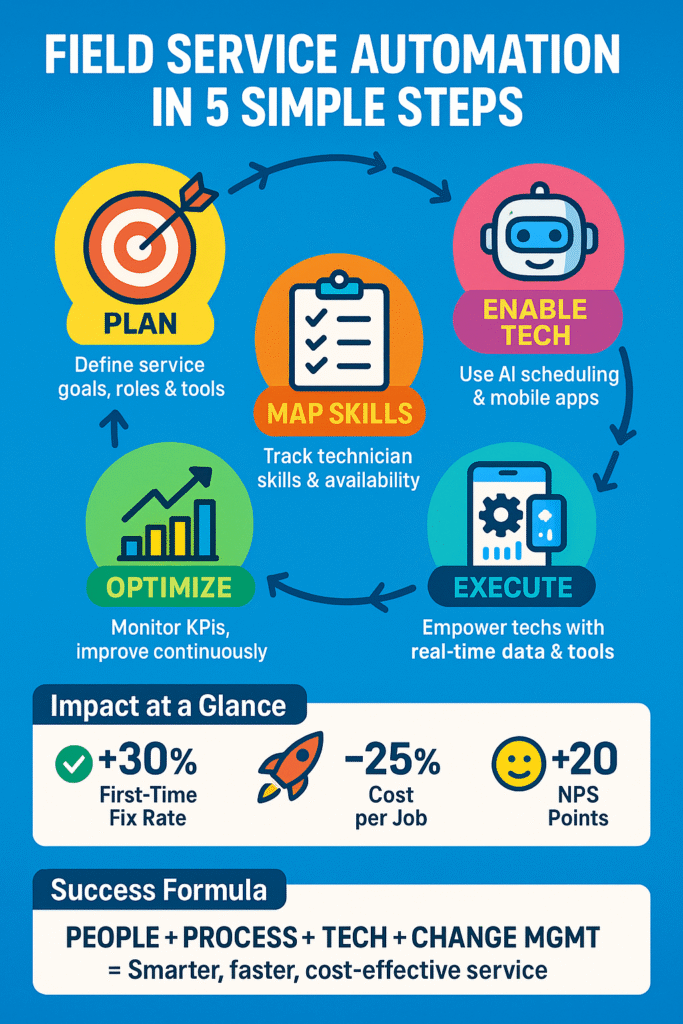Deployment typically involves a multi-phase approach with technology, process, and people components working in sync.
Phase 1: Strategy & Planning
Key Activities:
- Define field service goals – What does the organization aim to achieve? (e.g., reduce service time, increase first-time fix rate, lower cost-to-serve)
- Define all field service roles – Who does what? (Include service managers, field technicians, service coordinators, etc.)
- Assess current systems – What systems are used by the service teams? (ERP, CRM, EAM, manual scheduling tools)
- Build service taxonomy – Is proper skill assessment done across the workforce? (Documented skill matrix, standardized levels, certifications, asset types, regions, etc.)
Outcome:
A clear roadmap aligned with business KPIs and service-level goals.
Phase 2: Map Competency & Availability
Key Activities:
- Create a technician competency matrix (skills, certifications, training records) using the Skill Ops platform
- Integrate with HR/learning systems for real-time skill data updates
- Capture technician availability including shift schedules, time-off, and location
Outcome:
A dynamic technician profile database that supports intelligent dispatching.
Phase 3: Technology Enablement
Platform Components:
- Field Service Management Platform using Sync 360 Expert
- Scheduling Engine with AI/ML: Automates dispatch based on location, skill, availability, workload
- Mobile Field Technician App: Real-time job details, digital checklists, asset history, manuals, knowledge base
- Customer Portal (optional): For service request creation, technician tracking, and feedback submission
Integrations:
- ERP/CRM platforms to manage customer information, warranty details, and order history
- Asset Management for installed base details and asset health
- Knowledge Management for guided on-site troubleshooting
Outcome:
An integrated field service ecosystem that automates scheduling, dispatch, and execution.
Phase 4: Field Execution & Mobility
Key Activities:
- Equip field teams with mobile apps or tablets
- Offer access on demand to:
- Work orders and job location
- Asset service history
- Digital service manuals and troubleshooting guides
- Spare parts availability and ordering
- Real-time collaboration or remote support via video/AR
Outcome:
Technicians are self-sufficient, more productive, and capable of delivering a better service experience.
Phase 5: Monitoring & Optimization
Key Activities:
- Track key performance indicators (first-time fix rate, technician efficiency, travel duration, response speed)
- Apply dynamic dashboards and analytics to fine-tune dispatch strategies
- Gather insights from technicians and customers to drive ongoing improvements
Outcome:
Consistent gains in service quality, workforce effectiveness, and customer satisfaction.
Key Success Factors
| Area | Key Enablers |
| People | Competency-based workforce planning, continuous training |
| Process | Standardized workflows, digital SOPs, escalation paths |
| Technology | Robust FSM platform, AI scheduling, mobile enablement, integrations |
| Change Management | Technician buy-in, stakeholder alignment, leadership sponsorship |
Quantifiable Business Benefits
| Metric | Typical Improvement |
| Technician productivity | +25–35% |
| First-time fix rate | +20–30% |
| Service cost per job | −15–25% |
| Downtime reduction | −20–30% |
| Customer satisfaction (NPS) | +10–20 points |
| Response time | −30–40% |
Use Case Example: OEM Deployed FSA for Aftermarket Service
A global industrial equipment OEM implemented FSA to manage 600+ service technicians across 12 countries. By automating technician dispatch based on skill, location, and availability, and integrating with their ERP and IoT platforms:
- First-time fix rate improved from 62% to 82%
- Average response time dropped by 38%
- Aftermarket service revenue grew by 18% YoY
- Customer satisfaction rose by 22 points (NPS)
Conclusion
Field Service Automation empowers manufacturers and OEMs to move from manual, reactive service to automated, predictive, and customer-centric field operations.
By intelligently matching technician competency and availability to job requirements, organizations can:
- Speed up service execution and improve operational efficiency
- Cut expenses and prevent unplanned equipment breakdowns
- Increase aftermarket margins and drive recurring revenue
In today’s digital era, field service has evolved from a support role to a key competitive advantage.
Are you still relying on manual service coordination?It’s time to shift to a smarter, automated field service model. Let’s talk about how we can optimize your service operations—drop a message or connect now.









